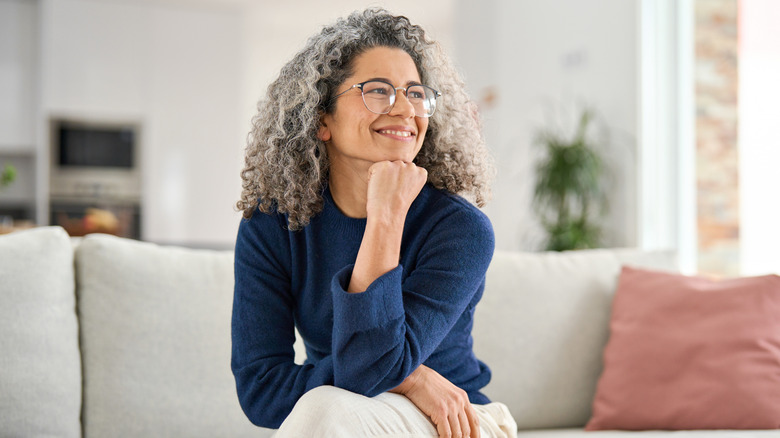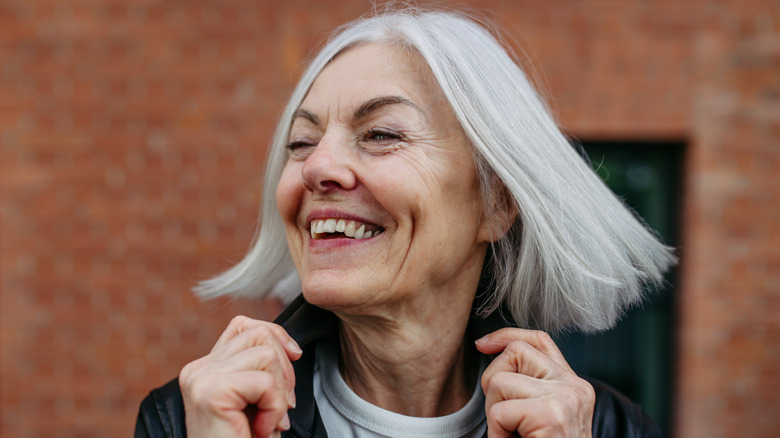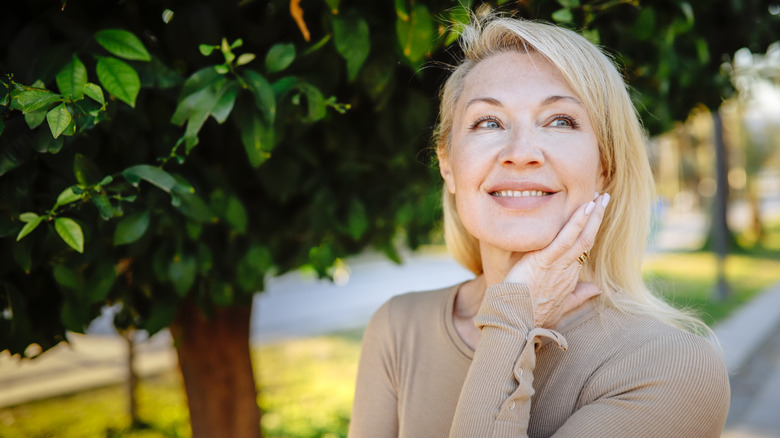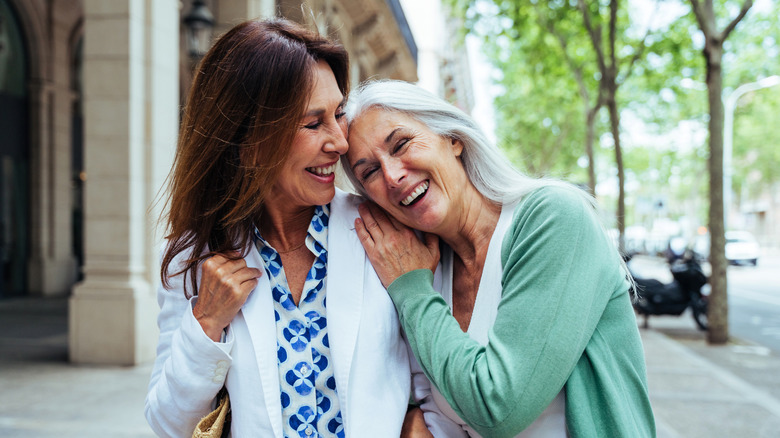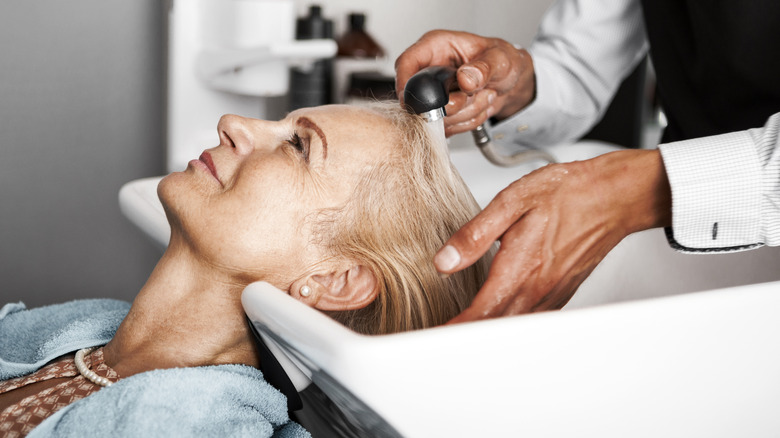How To Maintain Healthy Hair In Your 50s & Beyond
By your 50s, the luscious hair you once twisted absentmindedly around a finger may feel like a distant memory. Your part might be wider, the texture stranger, the ponytail thinner, the roots more visible, and the rituals that once delivered reliable results now offering only diminishing returns. In other words, your formerly low-maintenance strands require more TLC. These changes are predictable, even textbook, but that doesn't make them any less disorienting, especially when you're still adjusting to how your hair changes as you age, and figuring out how you should change with it
But if hair is one of the most visible signals of aging, it's also one of the most responsive — at least, that's what Dr. Ross Kopelman, a hair restoration surgeon who works with many patients navigating this exact terrain, exclusively tells Women. "One of the biggest misconceptions," he shares, "is that once you hit a certain age, there's nothing you can do about hair loss. That's simply not true."
Admittedly, your hair will never act like it did at 25, but it's still capable of looking and feeling good with the right attention. The trick, Dr. Kopelman let us in on, is proactively fine-tuning how you wash, style, treat, and think about your hair. With a proper blueprint, rest assured: there are plenty of good hair days ahead.
Begin at the root
Hair, like most things, reflects its environment. And in this case, that environment is the scalp — an oft-overlooked territory that becomes even more critical with age. "For keeping hair shiny and strong after 50, I recommend prioritizing scalp health just as much as hair health," Dr. Kopelman says. Very few people treat their scalp with the same care they give their skin, and that's a big mistake. Over time, dead skin, product residue, and oil accumulation create congestion that can stifle follicles and dull even the healthiest strands.
Dr. Kopelman suggests starting with a weekly reset: a gentle exfoliation to clean buildup and stimulate blood flow. He points to products with ketoconazole, commonly found in dandruff shampoos, which helps calm the scalp and create a healthier environment for follicles to function.
But you might prefer something less clinical and want to go down a more botanical route instead. In which case, rosemary oil — a traditional remedy — is now finding scientific support. Studies have shown its effects on hair growth and scalp health mirror those of more traditional pharmaceuticals like minoxidil — the FDA-approved gold standard treatment for age-related hair thinning — when used consistently.
Healthy hair starts at the root. By giving your scalp the same targeted care and attention you give your face, you're setting the stage for stronger, thicker, shinier strands.
Aging hair is not a lost cause
Hair loss in one's fifties can feel predetermined, as though the only reasonable response is to grin and bear it. But Dr. Kopelman pushes against that kind of resignation. "I've treated patients in their 50s, 60s, even 70s with excellent results," he says. There's no need to assume that age renders intervention pointless; you just need a strategy.
Among the most promising tools he points out is low-dose oral minoxidil. Unlike its topical counterpart, it works systemically and sidesteps that sticky residue that often deters long-term use. It's especially effective for thinning and widening parts, two of the most common complaints among patients in this age group.
For those willing to go beyond the pharmacy aisle, Dr. Kopelman suggests in-office treatments like microneedling and platelet-rich plasma (PRP) injections. The latter involves injecting your own plasma into your scalp to reawaken sluggish follicles. And on the horizon: exosome hair loss therapy, which Dr. Kopelman also highlights as an emerging option. These regenerative cell messengers show early promise in improving both density and texture.
As we age, it can be difficult to decipher what's normal with hair loss, what's not, and everything in between. But if you're seeing a widening part, loss of volume around the crown, or more hair in the shower drain, it might be time to consult a specialist. If caught early and treated thoughtfully, aging hair often responds better than expected.
You need moisture in proportion
As we age, oil production on the scalp naturally slows, which means your hair might start to feel drier. The instinct is often to smother it in rich masks and heavy oils to restore what's missing, but mature hair tends to be finer and more porous, meaning it soaks up moisture quickly — sometimes too quickly — leaving it limp.
"Nourish the hair with lightweight, non-comedogenic oils like argan or squalane," Dr. Kopelman shares. Non-comedogenic, in this case, simply means the product won't clog the pores on your scalp — an important distinction, especially when follicle health is the goal. These lighter oils can help to restore gloss and suppleness without overwhelming delicate strands or flattening their texture. Leave-in mists are another smart option, as they're easy to apply and just as easy to scale back.
Dryness at the scalp level deserves its own care, so learn how to moisturize your scalp for ultimate hair health. Products containing aloe, hyaluronic acid, or even a small amount of urea can help restore balance to the skin itself, which in turn leads to healthier growth. If fullness is your concern, caffeine-based shampoos or peptide formulations might offer a subtle lift over time.
A regular trim might also help to rebalance moisture, encouraging shape and movement without relying on product. Often, moisture issues improve simply by choosing a style that distributes density well. Fortunately, there are plenty of flattering haircuts for women over 50.
Be kinder — and consistent — to your hair and your follicles
Overprocessing and overstyling are two of the most reliable ways to sabotage aging hair, especially when it's already more fragile by default. "Avoid tight hairstyles or harsh chemical treatments that stress follicles," advises Dr. Kopelman.
Picture a high and tight ponytail, slicked back with industrial determination. Add to that a round brush wielded with fervor, a weekly blowout, and the occasional backcomb tug for lift. Now, imagine how all that tension lands on a scalp already contending with reduced blood and hormonal flux.
The antidote is fairly unsexy, but it's far kinder to your precious locks. Let your hair air-dry when you can, and use soft-bristled brushes or tolerant wide-tooth combs. Swap elastic ties for silk scrunchies. Lower the heat setting on your tools, and use them less. If you color your hair, avoid reprocessing areas that have already been treated. It's also worth considering support from the inside out. A diet rich in protein, iron, and omega-3s alongside supplements like biotin can help reinforce what time and biology have begun to thin.
Ultimately, the goal is achieving the healthiest hair you can, not what you had at 25. Invest in health and consistency. "Results don't happen overnight, but they do happen with the right plan in place," Dr. Kopelman reassures Women. Hair growth cycles naturally slow with age, which means visible change takes time — often several months. But with a steady routine, healthy hair at any age is possible.
